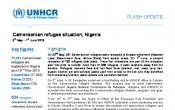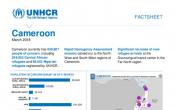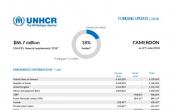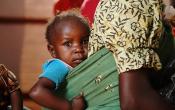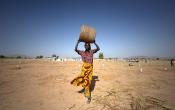Cameroon
Operation: Cameroon
Location
{"longitude":12,"latitude":5,"zoom_level":0,"iso_codes":"'CMR'"}
By clicking on the icons on the map, additional information is displayed.
Key Figures
| 2017 year-end results | |
| 108,000 | seedlings were planted to contribute to the protection of the environment and the promotion of peaceful coexistence |
| 23,090 | households received core relief items out of the 20,000 targeted |
| 6,820 | stateless persons were reached with legal and protection assistance and five advocacy sessions were conducted on eradication of statelessness |
| 2,960 | sanitary facilities were constructed/rehabilitated while 110 people of concern were trained in basic hygiene |
| 2,450 | shelter materials and maintenance toolkits and 1,400 transitional shelters were provided |
| 2018 planning figures | |
| 40,000 | Central African refugees will receive cash grants to allow them to return to their country of origin in the framework of voluntary repatriation |
| 29,000 | Nigerian refugees in Minawao camp will receive core relief items |
| 14,500 | Nigerian children will be enrolled in primary school |
| 1,765 | kilocalories, on average, per person per day will be distributed to Central African refugees |
| 20 | health facilities will be equipped/constructed/rehabilitated for Central African refugees and host populations |
Latest Updates and Related Links
People of Concern
30%
Increase in
2016
2016
| 2016 | 595,935 |
| 2015 | 459,650 |
| 2014 | 276,265 |

[["Refugees",348672],["Refugee-like situation",26743],["Asylum-seekers",3251],["IDPs",198889],["Returned IDPs",18213],["Returned refugees",134],["Others of concern",33]]
Loading ...
Cameroon
< Back
2017
{"categories":[2013,2014,2015,2016,2017,2018],"budget":[23.58358842,81.27658602,114.697643602,98.624602509,94.244828756,86.72780626],"expenditure":[12.96600018,44.17872352,50.71501571,50.50994132,48.4210928,null]}
{"categories":[2013,2014,2015,2016,2017,2018],"p1":[22.80065742,80.48365484,107.653576378,89.476459699,87.796062136,81.06977144],"p2":[0.782931,0.79293118,0.843987224,1.885381,1.14850401,0.53053251],"p3":[null,null,null,null,null,null],"p4":[null,null,6.20008,7.26276181,5.30026261,5.12750231]}
{"categories":[2013,2014,2015,2016,2017,2018],"p1":[12.84369964,44.04089519,45.95148629,46.39734147,46.55642961,null],"p2":[0.12230054,0.13782833,0.207295,1.36677006,0.31050242,null],"p3":[null,null,null,null,null,null],"p4":[null,null,4.55623442,2.74582979,1.55416077,null]}
Loading ...
CHOOSE A YEAR
- 2014
- 2015
- 2016
- 2017
- 2018
Operational context
Population movements remained dynamic in the Far North with Nigerian refugees fleeing the Boko Haram conflict in neighbouring North-Eastern Nigeria. Internal displacement and IDP returns continued; more Nigerian refugees arrived; and spontaneous return movements of refugees towards Nigeria took place.In the latter half of 2017, increased violence and tensions in the north-west and south-west of Cameroon resulted in outflows of Cameroonian asylum-seekers to Nigeria.
The maintaining of asylum space and respect for the principle of non-refoulement have been of particular concern in the volatile security environment in the Far North region. Humanitarian actors, in particular UN agencies, had little access to the border areas in Borno state in Nigeria. There were reported cases of refoulement from Cameroon, despite the UNHCR advocacy efforts and protest, and the commitments made under the framework of tripartite agreements. In March 2017, the Governments of Cameroon and Nigeria signed a tripartite agreement with UNHCR on the voluntary repatriation of Nigerian refugees.
Cameroon also faces potential issues relating to statelessness in the Bakassi Peninsula (ceded back by Nigeria in 2002) particularly with regards to nomadic and pastoralist populations in constant movement, living in border areas with the Central African Republic (CAR) and Nigeria who do not possess identity documents or birth certificates.
The increase in urban refugee population in 2017 is thought to be the result of the precariousness of the humanitarian situation in the countries of origin, in particular in the CAR, where violence continues to be meted against civil populations.
Population trends
In 2017:- 242,000 people were internally displaced in the Far North region, while 64,000 IDPs returned to their places of origin.
- Some 255,000 persons were estimated to be at risk of statelessness.
- More than 85,100 Nigerian refugees were residing in the Far-North region, of which over 60,000 lived in Minawao camp and the remainder in host villages in surrounding border areas.
- Close to 231,200 Central African refugees were in the East, North and Adamaoua regions, with around 30 per cent within the seven organized refugee sites and 70 per cent across more than 300 host villages.
- A total of 25,560 refugees and asylum-seekers from several nationalities in Yaoundé and Douala, representing a population increase of nearly 19 per cent compared to 2016. Therefore, the trend of reductions started in 2016 was reversed in 2017.
- Primary health care was provided to close to 8,340 people and in addition, some 2,020 refugees were referred to secondary or tertiary medical care. The under-5 mortality rate per 100 was notably reduced in 2017, due to increased support for some public health centres. Some 96 per cent of births were attended to by skilled personnel, and HIV services were increased from 60 per cent to 90 per cent, mainly due to the qualified midwives or maternal and child health staff.
- On self-reliance, 3,010 families had access to financial services, while another 1,810 people were engaged in self-employment/businesses. Some 46 per cent of Nigerian people of concern were earning the set minimum income for more than six months, exceeding the target of 15 per cent. In addition some 9,570 people with specific needs received in-kind support in 2017.
- To meet the shelter and settlement needs of people of concern, some 2,450 shelter materials and maintenance toolkits and 1,400 transitional shelters were provided. Some 90 per cent of people of concern lived in adequate dwellings. This is attributed partly to the provision of shelter support to more than 22,400 people of concern.
- 105 advocacy interventions were made—out of a target of 40—towards improving the access of people of concern to national legal services
- 43 missions to monitor conditions in IDP zones were conducted, exceeding the target set for the year: 15.
Unmet needs
- 50 per cent of the needs of all people of concern could not be met in 2017 due to lack of resources.
- Food security for Central African refugees remained deficient as ration cuts by WFP in 2017 resulted into only 42 per cent of food assistance. On average, WFP was able to provide only 1,260 Kcal per person per day, out of the required 2,100 Kcal. The gap in meeting food needs has exacerbated the already appalling nutritional situation, including acute and severe acute malnutrition rates affecting breast feeding babies.
- The water, sanitation and hygiene situation for Nigerian refugees in the Far North is precarious; 83 per cent of refugee households do not have a family toilet.
Working environment
Over the past two years, thousands of refugees from neighbouring countries have arrived in Cameroon. Over 259,000 refugees from the Central African Republic (CAR) are hosted in the East, Adamawa and North regions; 21,000 refugees and asylum-seekers in urban areas and about 73,745 Nigerian refugees in the Far North region. 192,000 remain internally displaced in the Far North.70 per cent of Central African refugees are settled within host communities across 300 villages, often located deep in the forest with limited access to humanitarian actors and government counterparts. Under these circumstances, ensuring a wide and coherent coverage of assistance and protection activities has become challenging. Refugees depend mainly on existing water, sanitation and hygiene (WASH), health and education infrastructures and services. The remaining 30 per cent are sheltered in the seven refugee sites where UNHCR and partners provide protection and multi-sectoral assistance.
Nigerian refugees are largely settled in the Far North region, an area affected by frequent Boko Haram incursions. Security measures are in place to restrict rebel incursions from both Nigeria and the Central African Republic into Cameroon, thus limiting the free movement of people and goods. Access to affected populations is also challenging, especially in the Far North region where the Government of Cameroon applies an encampment policy for refugees. 57,000 Nigerian refugees are accommodated in the Minawao camp where multi-sectoral services are also being provided by UNHCR and partners.
Key priorities
Refugees from the Central African Republic
As part of the search for durable solutions, UNHCR will focus on the gradual socio-economic integration of refugees. UNHCR will implement a self-reliance strategy to progressively increase the resilience of refugees and most vulnerable host communities, while reducing their dependence on humanitarian aid. The integration of refugees into national structures and support to an area-based development plan form the main components of the strategy. Development actors and administrative authorities will be increasingly involved in the response. UNHCR will coordinate possible returns once the pre-conditions for a safe and dignified return are in place.Nigerian refugees and IDPs
UNHCR will continue its advocacy efforts with national authorities to improve access to asylum and respect for the principle of non-refoulement, while taking into account national security measures. Screening of new arrivals and border monitoring will be undertaken jointly with Cameroonian authorities. Protection monitoring in refugee and IDP hosting areas will be ensured through a network of partners and local authorities, supported by UNHCR staff.UNHCR and partners will continue to improve living standards for refugees in all sectors in the Minawao camp as well as the protection of all refugees in camps and host villages. In addition to protection assistance, IDPs will continue to benefit from shelter and core-relief items support as required. UNHCR will coordinate possible refugee returns under tripartite arrangements once the pre-conditions for a safe and dignified return are in place and support IDPs opting to return to their areas of origin.
In the event of funding shortfalls to invest in basic health, education and WASH infrastructure in refugee hosting areas, Cameroonian authorities may be less inclined to continue accommodating large numbers of refugees. This may result in increased pressure to repatriate refugees in non-conducive conditions.
